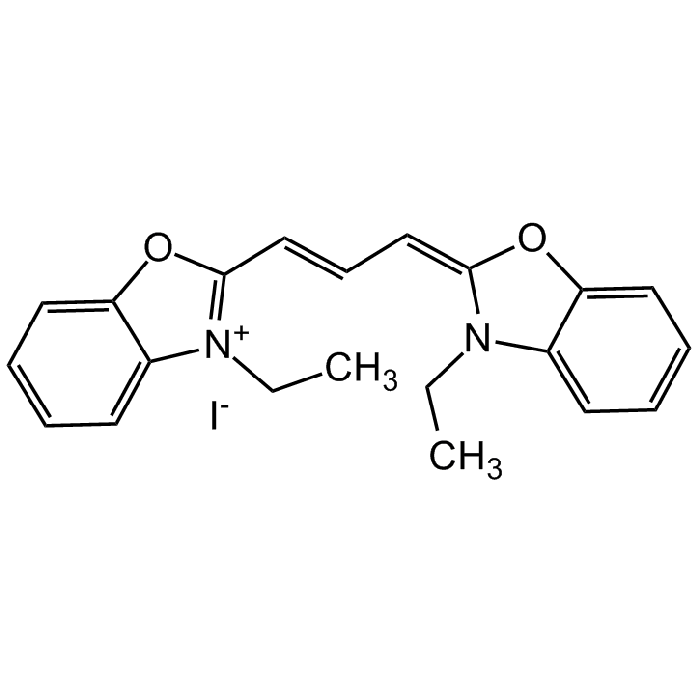Cookie Policy: This site uses cookies to improve your experience. You can find out more about our use of cookies in our Privacy Policy. By continuing to browse this site you agree to our use of cookies.
Chemodex
3,3'-Diethyloxacarbocyanine iodide

| Product Details | |
|---|---|
| Synonyms | DiOC2(3); 3-Ethyl-2-[3-(3-ethyl-2(3H)-benzoxazolylidene)-1-propenyl]benzoxazolium iodide; DOC iodide |
| Product Type | Chemical |
| Properties | |
| Formula |
C21H19IN2S |
| MW | 460.31 |
| CAS | 905-96-4 |
| Purity Chemicals | ≥98% (Titration) |
| Appearance | Dark red crystals or powder. |
| Solubility | Soluble in DMSO or methanol. |
| Identity | Determined by 1H-NMR. |
| Declaration | Manufactured by Chemodex. |
| Other Product Data |
Click here for Original Manufacturer Product Datasheet |
| InChi Key | FIZZUEJIOKEFFZ-UHFFFAOYSA-M |
| Smiles | CCN1/C(OC2=CC=CC=C12)=C\C=C\C3=[N+](CC)C4=CC=CC=C4O3.[I-] |
| Shipping and Handling | |
| Shipping | AMBIENT |
| Short Term Storage | +20°C |
| Long Term Storage | +20°C |
| Handling Advice | Protect from light and moisture. |
| Use/Stability | Stable for at least 2 years after receipt when stored at RT. |
| Documents | |
| Product Specification Sheet | |
| Datasheet |
 Download PDF Download PDF |
3,3'-Diethyloxacarbocyanine iodide is a cyanine based dye that has been used for measuring membrane potentials in bacteria. The green fluorescent dye forms red fluorescent aggregates with increasing membrane potential. The spectral shifting phenomenon has been exploited to measure membrane potential and analyze bacterial viability by flow cytometry ratiometrically. Spectral data: λmax 483nm (methanol); λem 498nm (methanol). The dye has also been used as laser dye and in photosensitization of mitochondria and endoplastic recticulum in animals and plant cells. It may be used as a conjugate for labelling cells for cytofluorometry studies and in the imaging of carbon nanotubes(CNTs) using fluorescence microscopy.
(1) D.N. Dempster, et al.; J. Chem. Soc. Faraday II 68, 1479 (1972) | (2) D. Magde & M.W. Windsor; Chem. Phys. Lett. 27, 31 (1974) | (3) M. Zalokar & C. Sardet; Dev. Biol. 102, 195 (1984) | (4) M. Castedo, et al.; J. Immunol. Meth. 265, 39 (2002) | (5) H.J. Broxterman, et al.; Leukemia 11, 1110 (1997) | (6) D.J. Novo, et al.; Cytometry 35, 55 (1999) | (7) D.J. Novo, et al.; Antimicrob. Agents Chemother. 44, 827 (2000) | (8) D.R. Gentry, et al.; J. Microbiol. Methods 83, 254 (2010) | (9) R.W. Sabnis; Handbook of biological dyes and stains (2010) | (10) M.A. Hudson, et al.; Antimicrob. Agents Chemother. 64, e00910 (2020)





